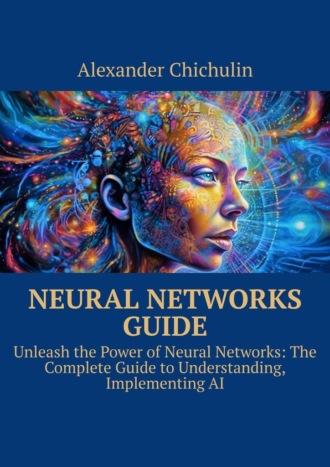
Полная версия
Neural networks guide. Unleash the power of Neural Networks: the complete guide to understanding, Implementing AI

Neural networks guide
Unleash the power of Neural Networks: the complete guide to understanding, Implementing AI
Alexander Chichulin
© Alexander Chichulin, 2023
ISBN 978-5-0060-1261-5
Created with Ridero smart publishing system
Introduction
Understanding Neural Networks: An Overview
What are Neural Networks?
Neural networks are computational models inspired by the human brain’s structure and functioning. They are designed to process and analyze complex patterns in data, learn from examples, and make predictions or decisions.
In simple terms, neural networks consist of interconnected nodes, called neurons, which are organized into layers. Each neuron receives input, performs a computation, and produces an output that is passed to other neurons. This interconnectedness allows neural networks to capture and represent intricate relationships within the data.
Neural networks are widely used in various fields, such as image and speech recognition, natural language processing, financial predictions, and many more. They excel at tasks that involve pattern recognition, classification, regression, and sequence processing.
By leveraging their ability to learn from data, neural networks can autonomously improve their performance over time through a process called training. During training, the network adjusts its internal parameters to minimize the difference between its predicted outputs and the desired outputs. This iterative learning process enables neural networks to become increasingly accurate and effective in solving complex problems.
Neural networks have gained significant attention and popularity due to their remarkable capabilities and applicability across a wide range of domains. Understanding the fundamentals of neural networks opens up exciting opportunities for leveraging their power in solving real-world problems.
Why are Neural Networks Important?
Neural networks have emerged as a crucial tool in the field of artificial intelligence and have revolutionized various industries. Here are some reasons why neural networks are important:
1. Powerful Pattern Recognition: Neural networks excel at recognizing patterns and extracting valuable information from complex data. They can identify intricate relationships, features, and structures that may not be easily discernible by traditional algorithms or human analysis. This ability makes neural networks valuable in tasks like image recognition, speech understanding, natural language processing, and data analysis.
2. Versatility and Adaptability: Neural networks are highly flexible and can be applied to a wide range of problems across different domains. They can learn from examples and adapt their internal parameters to perform specific tasks. This versatility allows neural networks to tackle diverse challenges, including image classification, language translation, fraud detection, medical diagnosis, and more.
3. Decision-Making and Predictive Abilities: Neural networks can make informed decisions and predictions based on learned patterns from historical data. They can process vast amounts of information, identify relevant features, and provide insights to support decision-making processes. Neural networks are valuable for tasks such as financial forecasting, customer behavior analysis, risk assessment, and personalized recommendations.
4. Automation and Efficiency: Neural networks have the potential to automate complex tasks and reduce human effort. Once trained, they can analyze and process data at high speeds, making them ideal for handling large-scale datasets and real-time applications. By automating repetitive and time-consuming processes, neural networks free up human resources for more strategic and creative endeavors.
5. Continuous Improvement: Neural networks possess the ability to learn and improve over time. Through iterative training, they refine their internal representations and adjust their parameters to optimize performance. This adaptability enables neural networks to adapt to changing environments, detect emerging patterns, and continuously enhance their accuracy and efficiency.
6. Cutting-Edge Technological Advances: Neural networks are at the forefront of technological advancements. Researchers and practitioners are constantly exploring new architectures, algorithms, and techniques to improve neural network performance and address complex challenges. Staying informed about neural network developments allows individuals and organizations to leverage the latest breakthroughs in AI and maintain a competitive edge.
In summary, neural networks play a vital role in solving complex problems, extracting insights from data, and driving advancements in various industries. Their ability to recognize patterns, make predictions, and adapt to new information makes them indispensable tools in the era of artificial intelligence.
How Neural Networks Mimic the Human Brain
Neural networks are inspired by the structure and functioning of the human brain. While they are not exact replicas of the brain, neural networks attempt to mimic certain aspects of its architecture and computational processes. Here’s how neural networks emulate the workings of the human brain:
1. Neurons: Neural networks consist of interconnected nodes called neurons, which are analogous to the neurons in the human brain. These artificial neurons receive input from other neurons, perform computations, and generate output signals.
2. Layers: Neural networks are organized into layers of neurons, similar to the layers of neurons found in the brain. Typically, there are input layers, hidden layers, and output layers. Information flows from the input layer through the hidden layers to the output layer, with each layer processing and transforming the data.
3. Activation: Artificial neurons in neural networks employ activation functions, which determine their output based on the input received. Activation functions simulate the firing or inhibition of neurons in the brain, translating input signals into meaningful outputs.
4. Learning from Data: Neural networks learn from examples through a process called training. During training, the network adjusts its internal parameters, known as weights and biases, to minimize the difference between its predicted outputs and the desired outputs. This mimics the brain’s ability to learn from experience and adapt its synaptic connections.
5. Parallel Processing: Neural networks are capable of parallel processing, which means multiple neurons can perform computations simultaneously. This parallelism allows neural networks to handle large amounts of data and perform complex computations efficiently, resembling the brain’s distributed processing capabilities.
6. Feature Extraction: Neural networks are adept at automatically extracting relevant features from input data. Through the hierarchical organization of layers, neural networks can learn to recognize and represent complex patterns and features, similar to how the brain processes sensory information and extracts meaningful representations.
7. Generalization: Neural networks aim to generalize from the examples they are trained on, enabling them to make accurate predictions or decisions on unseen data. This mirrors the brain’s ability to infer and recognize patterns beyond the specific instances it has encountered.
While neural networks strive to mimic certain aspects of the brain’s structure and functioning, it is important to note that they are simplified representations and do not encompass the full complexity of the human brain. Nonetheless, by drawing inspiration from the brain, neural networks provide a powerful computational framework for solving a wide range of problems and advancing the field of artificial intelligence.
Part I: Getting Started with Neural Networks
The Basics of Artificial Neural Networks
Components of a Neural Network
Neural networks consist of several components that work together to process data and make predictions. Let’s explore the key components of a neural network:
1. Neurons: Neurons are the fundamental units of a neural network. They receive input signals, perform computations, and produce output signals. Each neuron is connected to other neurons through weighted connections.
2. Weights and Biases: Connections between neurons in a neural network are associated with weights. These weights represent the strength or importance of the connection. During training, the network adjusts these weights to learn from data. Biases are additional parameters that help adjust the output of neurons, providing flexibility to the network.
3. Activation Functions: Activation functions introduce non-linearity to the neural network. They transform the weighted sum of inputs in a neuron into an output signal. Common activation functions include the sigmoid function, which maps inputs to a range between 0 and 1, and the rectified linear unit (ReLU), which outputs the input if it is positive, and 0 otherwise.
4. Layers: Neural networks are organized into layers, which are groups of neurons. The three main types of layers are:
– Input Layer: The input layer receives the initial data and passes it to the next layer.
– Hidden Layers: Hidden layers process intermediate representations of the data. They extract features and learn complex patterns.
– Output Layer: The output layer produces the final output or prediction of the neural network. The number of neurons in this layer depends on the specific problem the network is designed to solve.
The organization of layers and the connections between neurons allow information to flow through the network, with each layer contributing to the overall computation and transformation of data.
Understanding the components of a neural network is essential for configuring the network architecture, setting initial weights and biases, and implementing the appropriate activation functions. These components collectively enable the network to learn from data, make predictions, and solve complex problems.
Activation Functions
Activation functions play a crucial role in neural networks by introducing non-linearity to the computations performed by neurons. They transform the weighted sum of inputs into an output signal, allowing neural networks to model complex relationships and make accurate predictions. Let’s explore some common activation functions used in neural networks:
1. Sigmoid Function: The sigmoid function maps inputs to a range between 0 and 1. It has an S-shaped curve and is often used in binary classification problems. The sigmoid function is defined as:
f (x) = 1 / (1 + e^ (-x))
The output of the sigmoid function represents the probability or confidence level associated with a particular class or event.
2. Rectified Linear Unit (ReLU): The ReLU function is a popular activation function used in hidden layers of neural networks. It outputs the input value if it is positive, and 0 otherwise. Mathematically, the ReLU function is defined as:
f (x) = max (0, x)
ReLU introduces sparsity and non-linearity to the network, helping it learn and represent complex features in the data.
3. Softmax Function: The softmax function is commonly used in multi-class classification problems. It takes a set of inputs and converts them into probabilities, ensuring that the probabilities sum up to 1. The softmax function is defined as:
f (x_i) = e^ (x_i) / sum (e^ (x_j)), for each x_i in the set of inputs
The output of the softmax function represents the probability distribution over multiple classes, enabling the network to make predictions for each class.
These are just a few examples of activation functions used in neural networks. Other activation functions, such as tanh (hyperbolic tangent), Leaky ReLU, and exponential linear unit (ELU), also exist and are employed depending on the nature of the problem and network architecture.
Choosing an appropriate activation function is crucial as it influences the network’s learning dynamics, convergence, and overall performance. It is often a matter of experimentation and domain knowledge to determine the most suitable activation function for a given task.
Neural Network Architectures
Neural network architectures refer to the specific arrangements and configurations of neurons and layers within a neural network. Different architectures are designed to handle various types of data and address specific tasks. Let’s explore some common neural network architectures:
1. Feedforward Neural Networks (FNN):
– Feedforward neural networks are the simplest and most common type of neural network.
– Information flows in one direction, from the input layer through the hidden layers to the output layer, without cycles or loops.
– FNNs are widely used for tasks such as classification, regression, and pattern recognition.
– They can have varying numbers of hidden layers and neurons within each layer.
2. Convolutional Neural Networks (CNN):
– Convolutional neural networks are primarily used for processing grid-like data, such as images, video frames, or time series data.
– They utilize specialized layers, like convolutional and pooling layers, to extract spatial or temporal features from the data.
– CNNs excel at tasks like image classification, object detection, and image segmentation.
– They are designed to capture local patterns and hierarchies in the data.
3. Recurrent Neural Networks (RNN):
– Recurrent neural networks are designed for sequential data processing, where the output depends not only on the current input but also on past inputs.
– They have recurrent connections within the network, allowing information to be stored and passed between time steps.
– RNNs are used in tasks such as natural language processing, speech recognition, and time series prediction.
– Long Short-Term Memory (LSTM) and Gated Recurrent Unit (GRU) are popular variants of RNNs that help address the vanishing gradient problem and capture long-term dependencies.
4. Generative Adversarial Networks (GAN):
– Generative adversarial networks consist of two networks: a generator and a discriminator.
– The generator network learns to generate synthetic data that resembles the real data, while the discriminator network learns to distinguish between real and fake data.
– GANs are used for tasks like image generation, text generation, and data synthesis.
– They have shown remarkable success in generating realistic and high-quality samples.
5. Reinforcement Learning Networks (RLN):
– Reinforcement learning networks combine neural networks with reinforcement learning algorithms.
– They learn to make optimal decisions in an environment by interacting with it and receiving rewards or penalties.
– RLNs are employed in autonomous robotics, game playing, and sequential decision-making tasks.
– Deep Q-Networks (DQN) and Proximal Policy Optimization (PPO) are popular RLN algorithms.
These are just a few examples of neural network architectures, and there are numerous variations and combinations based on specific needs and research advancements. Understanding the characteristics and applications of different architectures enables practitioners to choose the most suitable design for their particular problem domain.
Training Neural Networks
Training neural networks involves the process of optimizing the network’s parameters to learn from data and make accurate predictions. Training allows the network to adjust its weights and biases based on the provided examples. Let’s delve into the key aspects of training neural networks:
1. Loss Functions:
– Loss functions measure the difference between the predicted outputs of the network and the desired outputs.
– Common loss functions include mean squared error (MSE) for regression tasks and categorical cross-entropy for classification tasks.
– The choice of the loss function depends on the nature of the problem and the desired optimization objective.
2. Backpropagation:
– Backpropagation is a fundamental algorithm for training neural networks.
– It calculates the gradients of the loss function with respect to the network’s parameters (weights and biases).
– Gradients represent the direction and magnitude of the steepest descent, indicating how the parameters should be updated to minimize the loss.
– Backpropagation propagates the gradients backward through the network, layer by layer, using the chain rule of calculus.
3. Gradient Descent:
– Gradient descent is an optimization algorithm used to update the network’s parameters based on the calculated gradients.
– It iteratively adjusts the weights and biases in the direction opposite to the gradients, gradually minimizing the loss.
– The learning rate determines the step size taken in each iteration. It balances the trade-off between convergence speed and overshooting.
– Popular variants of gradient descent include stochastic gradient descent (SGD), mini-batch gradient descent, and Adam optimization.
4. Training Data and Batches:
– Neural networks are trained using a large dataset that contains input examples and their corresponding desired outputs.
– Training data is divided into batches, which are smaller subsets of the entire dataset.
– Batches are used to update the network’s parameters iteratively, reducing computational requirements and allowing for better generalization.
5. Overfitting and Regularization:
– Overfitting occurs when the neural network learns to perform well on the training data but fails to generalize to unseen data.
– Regularization techniques, such as L1 or L2 regularization, dropout, or early stopping, help prevent overfitting.
– Regularization introduces constraints on the network’s parameters, promoting simplicity and reducing excessive complexity.
6. Hyperparameter Tuning:
– Hyperparameters are settings that control the behavior and performance of the neural network during training.
– Examples of hyperparameters include the learning rate, number of hidden layers, number of neurons per layer, activation functions, and regularization strength.
– Hyperparameter tuning involves selecting the optimal combination of hyperparameters through experimentation or automated techniques like grid search or random search.
Training neural networks requires careful consideration of various factors, including the choice of loss function, proper implementation of backpropagation, optimization using gradient descent, and handling overfitting. Experimentation and fine-tuning of hyperparameters play a crucial role in achieving the best performance and ensuring the network generalizes well to unseen data.
Preparing Data for Neural Networks
Data Representation and Feature Scaling
In this chapter, we will explore the importance of data representation and feature scaling in neural networks. How data is represented and scaled can significantly impact the performance and effectiveness of the network. Let’s delve into these key concepts:
1. Data Representation:
– The way data is represented and encoded affects how well the neural network can extract meaningful patterns and make accurate predictions.
– Categorical data, such as text or nominal variables, often needs to be converted into numerical representations. This process is called one-hot encoding, where each category is represented as a binary vector.
– Numerical data should be scaled to a similar range to prevent certain features from dominating others. Scaling ensures that each feature contributes proportionately to the overall prediction.
2. Feature Scaling:
– Feature scaling is the process of normalizing or standardizing the numerical features in the dataset.
– Normalization scales the data to a range between 0 and 1 by subtracting the minimum value and dividing by the range (maximum minus minimum).
– Standardization transforms the data to have a mean of 0 and a standard deviation of 1 by subtracting the mean and dividing by the standard deviation.
– Feature scaling helps prevent certain features from dominating others due to differences in their magnitudes, ensuring fair and balanced learning.
3. Handling Missing Data:
– Missing data can pose challenges in training neural networks.
– Various approaches can be used to handle missing data, such as imputation techniques that fill in missing values based on statistical measures or using dedicated neural network architectures that can handle missing values directly.
– The choice of handling missing data depends on the nature and quantity of missing values in the dataset.
4. Dealing with Imbalanced Data:
– Imbalanced data occurs when one class or category is significantly more prevalent than others in the dataset.
– Imbalanced data can lead to biased predictions, where the network tends to favor the majority class.
– Techniques to address imbalanced data include oversampling the minority class, undersampling the majority class, or using algorithms specifically designed for imbalanced data, such as SMOTE (Synthetic Minority Over-sampling Technique).
5. Feature Engineering:
– Feature engineering involves transforming or creating new features from the existing dataset to enhance the network’s predictive power.
– Techniques such as polynomial features, interaction terms, or domain-specific transformations can be applied to derive more informative features.
– Feature engineering requires domain knowledge and an understanding of the problem at hand.
Proper data representation, feature scaling, handling missing data, dealing with imbalanced data, and thoughtful feature engineering are crucial steps in preparing the data for neural network training. These processes ensure that the data is in a suitable form for the network to learn effectively and make accurate predictions.
Data Preprocessing Techniques
Data preprocessing plays a vital role in preparing the data for neural network training. It involves a series of techniques and steps to clean, transform, and normalize the data. In this chapter, we will explore some common data preprocessing techniques used in neural networks:
1. Data Cleaning:
– Data cleaning involves handling missing values, outliers, and inconsistencies in the dataset.
– Missing values can be imputed using techniques like mean imputation, median imputation, or imputation based on statistical models.
– Outliers, which are extreme values that deviate from the majority of the data, can be detected and either removed or treated using methods like Winsorization or replacing with statistically plausible values.
– Inconsistent data, such as conflicting entries or formatting issues, can be resolved through data validation and standardization.
2. Data Normalization and Standardization:
– Data normalization and standardization are techniques used to scale numerical features to a similar range.
– Normalization scales the data to a range between 0 and 1, while standardization transforms the data to have a mean of 0 and a standard deviation of 1.
– Normalization is often suitable for algorithms that assume a bounded input range, while standardization is useful when features have varying scales and distributions.
3. One-Hot Encoding:
– One-hot encoding is used to represent categorical variables as binary vectors.
– Each category is transformed into a binary vector, where only one element is 1 (indicating the presence of that category) and the others are 0.
– One-hot encoding allows categorical data to be used as input in neural networks, enabling them to process non-numerical information.
4. Feature Scaling:
– Feature scaling ensures that numerical features are on a similar scale, preventing some features from dominating others due to differences in magnitudes.











